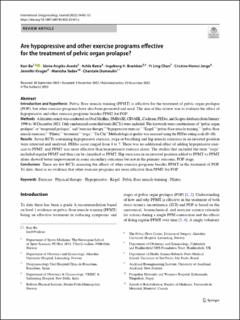| dc.contributor.author | Bø, Kari | |
| dc.contributor.author | Anglès‑Acedo, Sònia | |
| dc.contributor.author | Batra, Achla | |
| dc.contributor.author | Brækken, Ingeborg Hoff | |
| dc.contributor.author | Chan, Yi Ling | |
| dc.contributor.author | Jorge, Cristine Homsi | |
| dc.contributor.author | Kruger, Jennifer | |
| dc.contributor.author | Yadav, Manisha | |
| dc.contributor.author | Dumoulin, Chantale | |
| dc.date.accessioned | 2023-02-27T10:24:08Z | |
| dc.date.available | 2023-02-27T10:24:08Z | |
| dc.date.created | 2022-12-02T14:02:31Z | |
| dc.date.issued | 2022 | |
| dc.identifier.citation | International Urogynecology Journal. 2023, 34(2023), Side 43-52. | en_US |
| dc.identifier.issn | 0937-3462 | |
| dc.identifier.uri | https://hdl.handle.net/11250/3054147 | |
| dc.description | This article is licensed under a Creative Commons Attribution 4.0 International License, which permits use, sharing, adaptation, distribution and reproduction in any medium or format, as long as you give appropriate credit to the original author(s) and the source, provide a link to the Creative Commons licence, and indicate if changes were made. The images or other third party material in this article are included in the article's Creative Commons licence, unless indicated otherwise in a credit line to the material. If material is not included in the article's Creative Commons licence and your intended use is not permitted by statutory regulation or exceeds the permitted use, you will need to obtain permission directly from the copyright holder. | en_US |
| dc.description.abstract | Introduction and hypothesis: Pelvic floor muscle training (PFMT) is effective for the treatment of pelvic organ prolapse (POP), but other exercise programs have also been promoted and used. The aim of this review was to evaluate the effect of hypopressive and other exercise programs besides PFMT for POP.
Methods: A literature search was conducted on Ovid Medline, EMBASE, CINAHL, Cochrane, PEDro, and Scopus databases from January 1996 to 30 December 2021. Only randomized controlled trials (RCTs) were included. The keywords were combinations of “pelvic organ prolapse” or “urogenital prolapse,” and “exercise therapy,” “hypopressive exercise,” “Kegel,” “pelvic floor muscle training,” “pelvic floor muscle exercises,” “Pilates,” “treatment,” “yoga,” “Tai Chi.” Methodological quality was assessed using the PEDro rating scale (0–10).
Results: Seven RCTs containing hypopressive exercise, yoga or breathing and hip muscle exercises in an inverted position were retrieved and analyzed. PEDro score ranged from 4 to 7. There was no additional effect of adding hypopressive exercise to PFMT, and PFMT was more effective than hypopressive exercise alone. The studies that included the term “yoga” included regular PFMT and thus can be classified as PFMT. Hip exercises in an inverted position added to PFMT vs PFMT alone showed better improvement in some secondary outcomes but not in the primary outcome, POP stage.
Conclusions: There are few RCTs assessing the effects of other exercise programs besides PFMT in the treatment of POP. To date, there is no evidence that other exercise programs are more effective than PFMT for POP. | en_US |
| dc.language.iso | eng | en_US |
| dc.subject | exercise | en_US |
| dc.subject | hypopressive | en_US |
| dc.subject | kegel | en_US |
| dc.subject | pelvic floor muscle training | en_US |
| dc.subject | physical therapy | en_US |
| dc.subject | pilates | en_US |
| dc.title | Are hypopressive and other exercise programs effective for the treatment of pelvic organ prolapse? | en_US |
| dc.type | Peer reviewed | en_US |
| dc.type | Journal article | en_US |
| dc.description.version | publishedVersion | en_US |
| dc.rights.holder | © The Author(s) 2022 | en_US |
| dc.source.pagenumber | 43-52 | en_US |
| dc.source.volume | 34 | en_US |
| dc.source.journal | International Urogynecology Journal | en_US |
| dc.identifier.doi | 10.1007/s00192-022-05407-y | |
| dc.identifier.cristin | 2087814 | |
| dc.description.localcode | Institutt for idrettsmedisinske fag / Department of Sports Medicine | en_US |
| cristin.ispublished | true | |
| cristin.fulltext | original | |
| cristin.qualitycode | 1 | |
